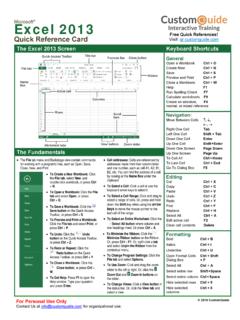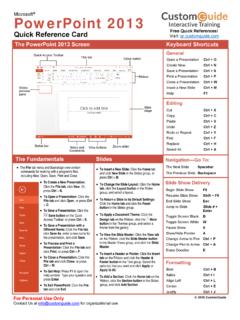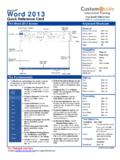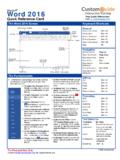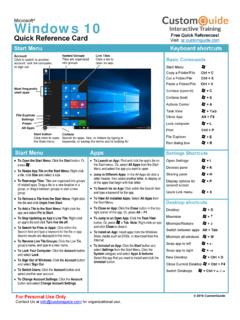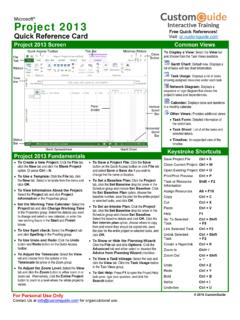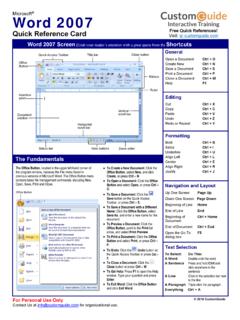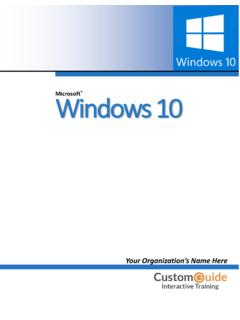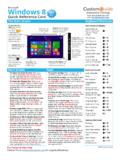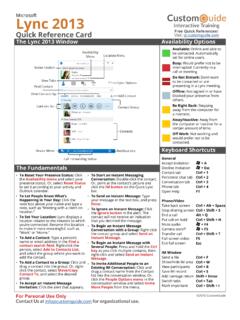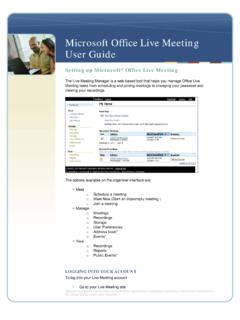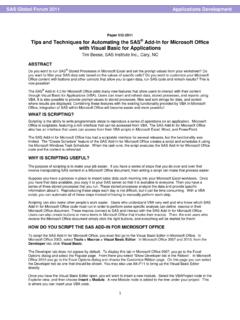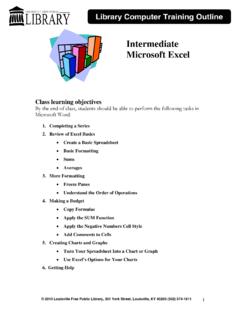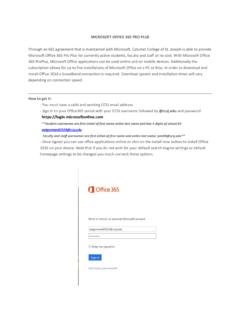Transcription of Microsoft Outlook 2016 - Microsoft Office Training
1 Status Bar Microsoft Outlook 2016 Quick Reference Card To Access the Inbox: click the Mail button in the Navigation Bar. To Check for New Messages: click the Send/Receive button on the Quick Access toolbar, or press F9. Message Indicators: Message has not been read. File is attached to the message. Message has high or low importance. To Open a Message: click a message to preview or double- click to open it. To Reply to the Message Sender: click the message, click the Reply button , type your reply, and click the Send button . To Reply to All Message Recipients: click the message, click the Reply to All button , type your reply, and click the Send button . To Forward a Message: click the message, click the Forward button , enter e-mail addresses in the To box, enter comments in the text box, and click the Send button .
2 To Delete a Message: Select the message and press the Delete key. To Create a New the New button or press Ctrl + N. the e-mail addresses in the To box, or click the To button to use the address book. the Cc button and select the e-mail addresses for recipients to whom you want to send a copy of the message. the subject of the message in the Subject box. the text of your message in the text box. the Send button . To Attach a File: Create a new message, click the Attach File button in the Include group on the Ribbon in the Message window, select the file you want to send, and click Insert. To Send a Blind Carbon Copy (Bcc): In themessage window, click the Options tab on the Ribbon and select Show Bcc in the Fields group.
3 click the Bcc: button and select the e-mail addresses for recipients to whom you want to send a blind copy of the message. To Open an Attachment: Double- click the attachment at the top of the message window. Outlook 2016 Screen Mail folders Title Bar Messages Navigation Bar Ribbon To-Do Bar Reading Pane Navigation Pane Shortcuts Add shortcuts to folders and locations in Outlook for quick access. Use to organize to-do lists, track task progress, and delegate tasks. Contains mail-related folders like your Inbox, Sent Items and Search Folders. Use the Favorite Folders at the top of the pane for easy access to frequently-used mail folders. Enables you to view and schedule appointments, events, and meetings.
4 View shared calendars and compare calendars by viewing them side by side. Use to store and keep track of addresses, numbers, and e-mail addresses. Notes Use like electronic Post-It Notes to write down information. Folder List Displays a list of all your Outlook folders in the Navigation pane. Messages: Basic Tasks New Delete Move to Folder Reply to the Sender Reply to All Recipients Forward Message Address Book Find a Contact Mark for Follow UpSave Ctrl + S Print Ctrl + P Undo Ctrl + Z Cut Ctrl + X Copy Ctrl + C Paste Ctrl + V Check Spelling F7 Check for Mail F9 Save, Close, Alt + S and Send Reply Ctrl + R Reply to All Alt + L Address Book Ctrl + Shift + B Help F1 Switch Between Alt + Tab Applications New Item Ctrl + N Keyboard Shortcuts Free Quick References!
5 Visit: 2016 CustomGuide For Personal Use Only Contact Us at for organizational use. Message Window Features Like in Outlook 2010, the File menu and Ribbon replace the Office button and Standard Toolbar in Outlook 2013. Ribbon Quick Access Toolbar Calendar Contacts To Flag a Message as a To-Do Item: Right- click the message, select Follow Upfrom the contextual menu, and select a flag. Or, click the flag icon on the message. Or, select the message, click the Follow Up button on the Ribbon and select a flag. To Clear a Flagged Message: Right- click the message, select Follow Up from the contextual menu, and select Clear Flag. To Categorize a Message by Color: click the Quick click icon on the message.
6 Or, right- click the message, select Categorize from the contextual menu,and select a color category. Or, select the message, click the Categorize button onthe Ribbon, and select a flag. To Recall a Message: Open the Sent Items folder. Double- click the message, click the Actions button in the Move group on the Ribbon, and select Recall This Message. Choose to delete the message or replace the message with a new one in the dialog box and click OK. You can only recall a message if you are using MS Exchange Server and the recipient has not opened it. To Resend a Message: Open the Sent Items folder. Double- click the message, click the Actions button in the Move group on the Ribbon, and select Resend This Message.
7 Enter new recipients in the message window and click Send. To Save a Message as a Draft: click the Save button on the Quick Access Toolbar in the message window. The message appears in the Drafts folder. To Move an Item to a Different Folder: Select the item, click the Move to Folder button and select the destination folder. Or, click and drag the item to a different folder in the Navigation Pane. To View Your Contacts: click the People button in the Navigation Bar. To Create a New Contact: click the New Contact button on the Ribbon. To Edit a Contact: Double- click the contact. To Find a Contact: Type words to search for in the Search Contacts box. To Delete a Contact: Select the contact and press the Delete key.
8 To Change Views: Select the desired view in the Current View section of theContacts Navigation pane. To View the Calendar: click the Calendar button in the Navigation Bar. To Change Views: click the View tab on the menu bar and select the desired view. Or, click one of the Day, Week, or Month view buttons. To Schedule an Appointment: click the New Appointment button or press Ctrl + N. To Schedule a Recurring Appointment: click New Items on the Ribbon and select Appointment from the menu. click the Options arrow and then the Recurrencebutton. Fill in the fields and click OK. To Schedule a Meeting Request: click the New Meeting button on the Ribbon and in the type the contact that you wish to include.
9 To Schedule an All Day Event: click New Items arrow on the Ribbon and select New All Day Event from the menu. To Reschedule an Item: Double- click the meeting, appointment, or event, make your changes and click the Save & Close button . Tasks and To-Do Items To View Your Tasks: click the Tasks button in the Navigation Bar. To Create a New Task: click the New button , press <Ctrl + <N, or type a new task in the text box at the top of the window or in the Type a new task box in the To-Do Bar. To Complete a Task: In Simple List view, check the task s check box. To Delete a Task: Select the task and press the Delete key. To Create a Recurring Task: Double- click the task and click the Recurrence button on the Ribbon.
10 To Assign a Task: Double- click the task, click the Assign Task button in the Manage Task group on the Ribbon, enter the person s name in the To box, and click Send. To Create a Distribution List: click the New Items button arrow on the Ribbon and point to More Items and select Contact Group. click Add Members in theMembers group on the Ribbon, select the location of the contacts you wish to use and select a name in the list. click the Members button and repeat for each name to beadded. click OK, then click Save & Close in the Actions group. To Create a Signature: Go to File, select Options and click the Mail tab. click the Signatures button , and create the new signature.
